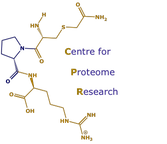Sperm proteomes, gone large
Bayram HL, Claydon AJ, Brownridge PJ, Hurst JL, Mileham A, Stockley P, Beynon RJ, Hammond DE.(2016) Cross-species proteomics in analysis of mammalian sperm proteins. J Proteomics. 2016 Mar 1;135:38-50. doi: 10.1016/j.jprot.2015.12.027
Many proteomics studies are conducted in model organisms for which fully
annotated, detailed, high quality proteomes are available. By contrast, many
studies in ecology and evolution are conducted in species which lack high quality
proteome data, limiting the perceived value of a proteomic approach for protein
discovery and quantification. This is particularly true of rapidly evolving
proteins in the reproductive system, such as those that have an immune function
or are under sexual selection, and can compromise the potential for cross-species
proteomics to yield confident identification. In this investigation we analysed
the sperm proteome, from a range of ungulates and rodents, and explored the
potential of routine proteomic workflows to yield characterisation and
quantification in non-model organisms. We report that database searching is
robust to cross-species matching for a mammalian core sperm proteome, comprising
623 proteins that were common to most of the 19 species studied here, suggesting
that these proteins are likely to be present and identifiable across many
mammalian sperm. Further, label-free quantification reveals a consistent pattern
of expression level. Functional analysis of this core proteome suggests
consistency with previous studies limited to model organisms and has value as a
quantitative reference for analysis of species-specific protein
characterisation.SIGNIFICANCE: From analysis of the sperm proteome for diverse
species (rodents and ungulates) using LC-MS/MS workflows and standard data
processing, we show that it is feasible to obtain cross-species matches for a
large number of proteins that can be filtered stringently to yield a highly
expressed mammalian sperm core proteome, for which label-free quantitative data
are also used to inform protein function and abundance.
Many proteomics studies are conducted in model organisms for which fully
annotated, detailed, high quality proteomes are available. By contrast, many
studies in ecology and evolution are conducted in species which lack high quality
proteome data, limiting the perceived value of a proteomic approach for protein
discovery and quantification. This is particularly true of rapidly evolving
proteins in the reproductive system, such as those that have an immune function
or are under sexual selection, and can compromise the potential for cross-species
proteomics to yield confident identification. In this investigation we analysed
the sperm proteome, from a range of ungulates and rodents, and explored the
potential of routine proteomic workflows to yield characterisation and
quantification in non-model organisms. We report that database searching is
robust to cross-species matching for a mammalian core sperm proteome, comprising
623 proteins that were common to most of the 19 species studied here, suggesting
that these proteins are likely to be present and identifiable across many
mammalian sperm. Further, label-free quantification reveals a consistent pattern
of expression level. Functional analysis of this core proteome suggests
consistency with previous studies limited to model organisms and has value as a
quantitative reference for analysis of species-specific protein
characterisation.SIGNIFICANCE: From analysis of the sperm proteome for diverse
species (rodents and ungulates) using LC-MS/MS workflows and standard data
processing, we show that it is feasible to obtain cross-species matches for a
large number of proteins that can be filtered stringently to yield a highly
expressed mammalian sperm core proteome, for which label-free quantitative data
are also used to inform protein function and abundance.
